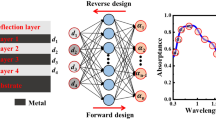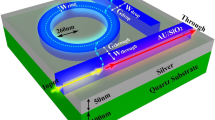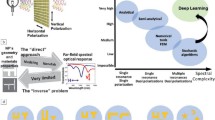Abstract
Predicting the behavior of photonic and Plasmon nanostructures has always been an attractive topic for photonic sciences researchers. One of the methods for estimating the behavior of devices in engineering sciences is adaptive neuro fuzzy inference system. Modeling and designing of photonic and plasmonic nanostructures and their optimization strongly relies on the timing of unstructured electromagnetic response simulations and optimal design requires a high number of simulations and if the optimal answer is reached, other simulation results will be wasted. Deep learning method which has been created by ANFIS networks provides a powerful and efficient device for creating accurate relationship between plasmonic geometric parameters and resonance spectrums. Millions of different nanostructures can be obtained without the need for any costly simulations and it costs only one investment to obtain training data. In this study, we use of deep learning based on ANFIS for predicting optic sensors’ answer by using plasmonic nano rods. In addition to prediction, this method can approximate a special answer based on photonic structure. In this study, ANFIS networks, at first, model a 5*5 array of plasmonic nanostructures based on obtained experimental data from optic absorption. In the following, based on obtained model, it designs nanoparticles geometry so that we achieve a relatively narrow absorption spectrum with high sensitivity in relation to change air refractive index. This method can be applied for other similar types of nano-photonic systems which can help to destroy simulation procedure and acceleration photonic sensor design trend.




Similar content being viewed by others
References
Akhlaghi, M., Farzin, E.: Fuzzy adaptive modified PSO-algorithm assisted to design of photonic crystal fiber Raman amplifier. J. Opt. Soc. Korea 17(3), 237–241 (2013)
Akhlaghi, M., et al.: Simulation and optimization of nonperiodic plasmonic nano-particles. J. Opt. Soc. Korea 18(1), 82–88 (2014)
Akhlaghi, M., et al.: Location effect on gold nano bi-domes based absorption coefficient. Opt. Quant. Electron. 47(7), 1713–1719 (2015)
Akhlaghi, M., Farzin, E., Najmeh, N.: Location effect on gold nano bi-domes based absorption coefficient. Opt. Quant. Electron. 47(7), 1713–1719 (2015)
Alghazali, K.M., et al.: Plasmonic nanofactors as switchable devices to promote or inhibit neuronal activity and function. Nanomaterials 9(7), 1029 (2019)
Apagyi, B., Endredi, G., Levay, P.: Inverse and Algebraic Quantum Scattering Theory, pp. 13–29. Springer, Lake Balaton, Hungary (1996)
Digehsara, P.A., et al.: An improved particle swarm optimization based on the reinforcement of the population initialization phase by scrambled Halton sequence. Cogent. Eng. 7(1), 1737383 (2020)
He, J., et al.: Plasmonic nanoparticle simulations and inverse design using machine learning. Nanoscale 11(37), 17444–17459 (2019)
Kaboli, M., Majid, A., Hossein, S.: Binary particle swarm optimization algorithm assisted to design of plasmonic nanospheres sensor. Waves Random Complex Media 26(2), 121–130 (2016)
Keshavarzi, R., et al.: Binary PSO algorithm assisted to investigate the optical sensor based plasmonic nano-bi-domes. Optik 127(19), 7670–7675 (2016)
Koushkaki, H.R., Majid, A.: Investigating the optical nand gate using plasmonic nano-spheres. Opt. Quant. Electron. 47(11), 3637–3645 (2015)
Koushkaki, H.R., et al.: Investigating the optical nand gate using plasmonic nano-spheres. Opt. Quant. Electron. 47(11), 3637–3645 (2015)
Liu, D., Tan, Y., Khoram, E., Yu, Z.: Training deep neural networks for the inverse design of nanophotonic structures. ACS Photonics 5, 1365–1369 (2018)
Malkiel, I., et al.: "Plasmonic nanostructure design and characterization via deep learning. Light Sci. Appl. 7(1), 1–8 (2018)
Martin, E., Meis, M., Mourenza, C., Rivas, D., Varas, F.: Fast solution of direct and inverse design problems concerning furnace operation conditions in steel industry. Appl. Therm. Eng. 47, 41–53 (2012)
Moon, G., et al.: Deep learning approach for enhanced detection of surface plasmon scattering. Anal. Chem. 91(15), 9538–9545 (2019)
Nelson, M.D., Di Vece, M.: Using a neural network to improve the optical absorption in halide perovskite layers containing core-shells silver nanoparticles. Nanomaterials 9(3), 437 (2019)
Peurifoy, J., Shen, Y., Jing, L., Yang, Y., Cano-Renteria, F., DeLacy, B.G., Joannopoulos, J.D., Tegmark, M., Soljacic, M.: Nanophotonic particle simulation and inverse design using artificial neural networks. Sci. Adv. 4, 4206 (2018)
Piggott, A.Y., Lu, J., Lagoudakis, K.G., Petykiewicz, J., Babinec, T.M., Vuckovic, J.: Inverse design and demonstration of a compact and broadband on-chip wavelength demultiplexer. Nat. Photonics 9, 374–377 (2015)
Yu, L., Kokenyesi, R.S., Keszler, D.A., Zunger, A.: Inverse design of high absorption thin-film photovoltaic materials. Adv. Energy Mater. 3, 43–48 (2013)
Author information
Authors and Affiliations
Corresponding author
Additional information
Publisher's Note
Springer Nature remains neutral with regard to jurisdictional claims in published maps and institutional affiliations.
Rights and permissions
About this article
Cite this article
Ganji, J., Kaboli, M., Tabatabaee, S.S. et al. Modeling and optimization of nano-rod plasmonic sensor by adaptive neuro fuzzy inference system (ANFIS). Opt Quant Electron 53, 88 (2021). https://doi.org/10.1007/s11082-020-02675-0
Received:
Accepted:
Published:
DOI: https://doi.org/10.1007/s11082-020-02675-0




